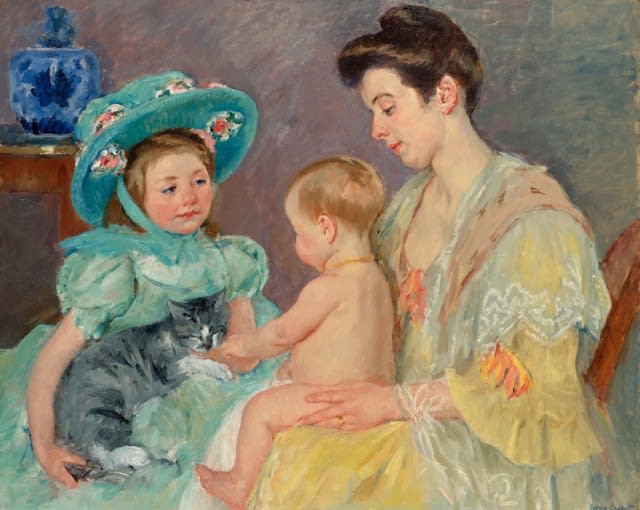Women should be someone and not something.
Those words, written by Mary Cassatt, don’t sound very radical in the twenty-first century, but were considered very radical when she wrote them, around the turn of the twentieth.
Mary Cassatt’s Determination
Mary Cassatt was born in 1844 and grew up in an upper middle class family in Pittsburgh. Like other women of her social station, she was given a good education that included learning art, music and language. The family also considered travel as an integral part of an education, and Cassatt was taken on trips to the capital cities of Europe.
The purpose of such an enriched education, of course, was to create a woman who would marry well, run a household efficiently and be able to entertain as required by her social status. Cassatt’s role model was her mother, Katherine Kelso Johnston, whom she depicted as a strong, competent woman, able to read front page news, in French, in the painting Reading Le Figaro.
To her parents’ consternation, Cassatt wanted to pursue art as a career. They reluctantly allowed her to attend the Pennsylvania Academy of the Fine Arts when she was fifteen. There were few other female students at the Academy and those who did attend were not allowed to go to figure drawing classes with live models but had to draw in separate classes from casts.
Cassatt was not satisfied with the education she was getting at the Academy and convinced her parents to let her study in Paris, with her mother going along as chaperone. In 1866, when Cassatt and her mother arrived in Paris, the Ecole des Beaux-Arts did not admit women, and would not do so until 1897.
Her determination led Cassatt to take private lessons and copy the master works at the Louvre on her own, alongside other female artists who worked as copyists, and earned money by selling their copies of the works.
Battling for Success
Her talent was so great that, two years after she arrived in Paris, Cassatt’s work was accepted for the Paris Salon, one of the first women to exhibit in the prestigious show. Her admiration for the work of Edgar Degas, especially his use of pastels, led to their friendship and Cassatt’s entree into the circle early impressionist painters.
Cassatt still had difficulty making a living with her art. Although her father refused to continue to support her painting and would only pay for basic necessities, she set up a studio in Paris.
As her reputation grew, and impressionist paintings became more admired by critics and the public, Cassatt was able to support herself as an artist. It was socially acceptable, and comfortable, for Cassatt to have female models and children in her studio and her paintings of nurturing mothers and their children became the hallmark of her career.
Cassatt’s Influence on Art and Women’s Issues
Mary Cassatt’s influence and appeal was strong in France, but slower to take hold in the U.S. One of her finest achievements was as an adviser to American art collectors. Many of the finest impressionist and old master paintings at the Metropolitan Museum are from the Havemeyer collection. Cassatt, who was a friend of the Havemeyers, helped them choose paintings for their collection and encouraged them to donate works to the Met.
It was Louisine Havemeyer who, in 1915, organized an exhibition of Cassatt’s work, in support of women’s suffrage. Although women in France did not get the vote until 1945, American women were given the right to vote in 1920.
Works of Mary Cassatt for Sale at Surovek
Please contact us if you would like more information about Sketch of a Mother Looking Down at Thomas, Children Playing with a Cat or any of the other Mary Cassatt artwork for sale.


